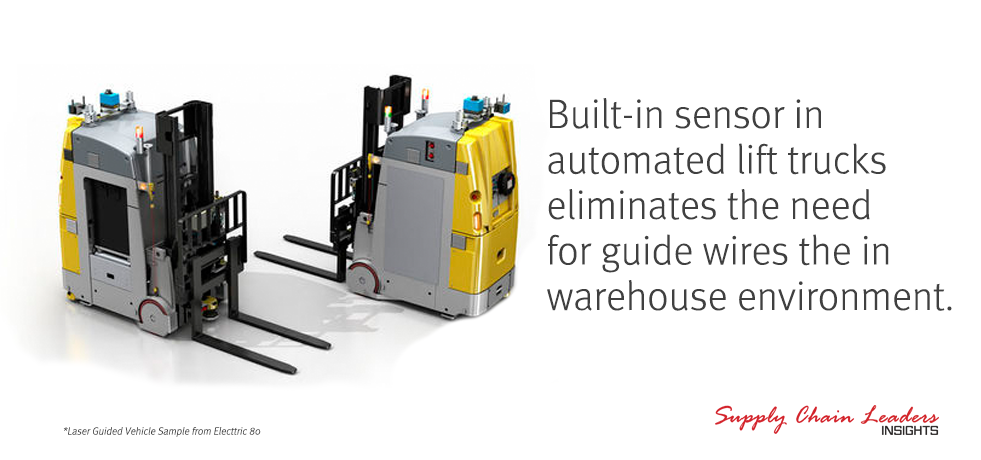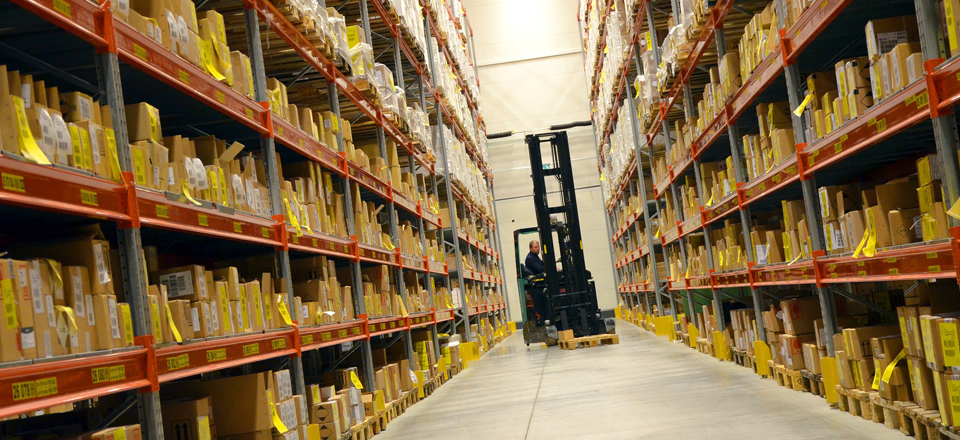Have you ever calculated the hourly cost of running lift trucks in your warehouse? If you have, I’ll be surprised if the driver’s salary doesn’t contribute to at least 70% of the cost. So what if you could implement an entire fleet of MHE, each vehicle operating at less than half what it costs to run your lift truck fleet today—without the need to dramatically change or upgrade your warehouse facility?
More Than Just a Cost-saver
The beauty of the latest breed of automated lift trucks is that built-in sensor technology eliminates the need for guide wires or other apparatus installed in the warehouse environment.
Driverless lift trucks, a growing trend in warehouse automation, are breaking free of the limitations of earlier AGVs, which made them unsuitable for many warehouses and too expensive for all but the largest organisations to invest in.
Equipped with what’s known as vision technology, the most advances driverless lift trucks are able to map the warehouse in which they operate, and then navigate the aisles and workspaces without the need for any exernal guidance cues.
These guidance syinatesstems, along with additional sub-systems to control safety measures and to interface the trucks with a compatible WMS platform, mean driverless trucks have more to offer than running-cost reductions

Lift Trucks and Warehouse Safety
Accidents in the workplace cost money and worse, cause human harm. Worse still, accidents involving lift trucks are often serious. Statistics indicate that lift truck accidents cause at least one fatality every week.
It stands to reason therefore, that separating humans and lift trucks can reduce the potential for accidents, especially when you add the fact that many lift truck accidents are caused by driver error.
I have watched many lift truck operators at work and can tell you that, mostly to increase productivity, the majority of them bypass standard safety practices, such as remaining stationary (with the safety brake engaged) while lifting or lowering their forks.
I have also witnessed more than one lift truck accident first-hand—and truly wish I hadn’t, given that one resulted in a fatality and another an amputated thumb (and I don’t mean surgically amputated).
No Driver, No Die (Sing to a Bob Marley Melody)
Standard safety practices are covered in lift truck driver training and I’m not going to criticise drivers for subsequently ignoring them. But do those same drivers always exercise impeccable judgement toward truck balance and centre of gravity while on the move?
Driverless lift trucks can’t ignore their programming and they don’t make judgement calls when it comes to what is or is not a safe manoeuvre.
Furthermore, sensor technology is now at a point where it’s more likely to stop a truck before collision than a human operator (provided truck and technology are maintained as they should be).
So … no driver riding the truck, onboard sensors and alarms to keep other humans at safe distances, programming which doesn’t allow unsafe manoeuvres—that’s a whole lot of danger factors removed from your warehouse, not to mention the reduced risk of inventory loss and damage.
Flexibility and Productivity
No driver means less risk of death, injury, or inventory loss, but it also means no need for shift changeovers, meal breaks or holidays.
Driverless lift trucks can run day and night, stopping only for refuelling or maintenance. In fact, some electric versions can even swap out batteries and resume operation without human intervention.
Therefore, even if driverless lift trucks operate more slowly than their manually guided counterparts, they can increase productivity by way of continuous operation. Better still, if your operation does require the flexibility to allow manual control for certain tasks, you can always opt for dual-mode trucks, which can be switched between manual and autonomous control.
Driverless Lift Trucks: A Realistic Proposition?
Driverless lift trucks are not yet a common sight in supply chain warehouses, although numbers are on the rise. There are operational hurdles still to overcome, such as difficulties in getting sensor-equipped vehicles to pass one another in an aisle instead of stopping (wider aisles are currently the only solution), and of course, there is always the touchy issue of job security among warehouse operatives.
So should you get excited about the possibility of driverless trucks in your warehouse, or is it still too soon?
To find out more about driverless lift trucks and the possibilities they afford, you could do worse than talk to a lift truck vendor or two.
Our Supply Chain Leaders Insights event, taking place soon, should offer a great opportunity to do just that. We hope to have some lift truck dealers present and even if they don’t deal in autonomous MHE, for sure they’ll be bang up to date with what’s out there and whether it’s time to get excited or not about driverless forklift trucks.

